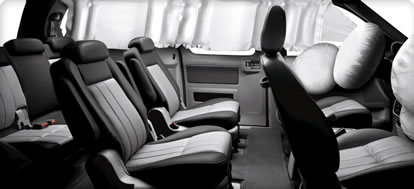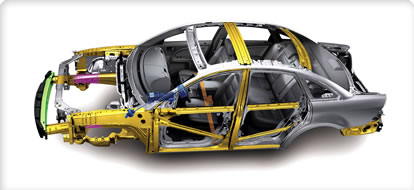Vehicle Safety
Safer Vehicles
In This Section
- Accident Avoidance Technologies
- Occupant Protection Technologies
- Injury Reduction Technologies
Occupant Protection Technologies
Many factors influence a vehicle's crashworthiness, including the design of the vehicle's structure to absorb impact energy and the use of passive safety equipment such as air bags. To help protect drivers and passengers in the event of a crash, a variety of Ford technologies have been designed to enhance the performance of safety belts and air bags and provide additional occupant protection in side crashes and rollovers.
The Ford Personal Safety System™ helps reduce the risk of injury to the driver and front passenger in the event of a moderate to severe frontal collision. The system is designed to adjust the deployment of the front air bags to enhance protection for front-seat occupants. It accomplishes this with the help of crash severity sensors, safety belt usage sensors, dual-stage driver and front-passenger air bags, a driver's seat position sensor and front outboard safety belt pretensioners. The Personal Safety System is standard on Ford vehicles in the United States.
The Ford Explorer and Mercury Mountaineer are equipped with additional features to enhance occupant protection during a side-impact event. Side-impact air bags mounted in the outboard side of each front seat enhance chest-area protection, and roof-mounted side curtains enhance head protection. Both are standard on many Ford vehicles. Door armrests and door trim also provide abdomen and lower torso cushions, and a four-inch-thick foam block inside each door helps to manage side-impact forces on occupants' hips.
Percent of Nameplates with Standard Offering of Side Airbags
| 2009 Model Year | 88% |
|---|---|
| 2008 Model Year | 72% |
| 2007 Model Year | 54% |
Ford was the first in the industry to offer rollover-activated side-curtain air bags, known as the Safety Canopy, beginning with the Ford Explorer and Mercury Mountaineer in 2002. Today, the Safety Canopy with rollover sensors – which helps protect vehicle occupants during side-impact collisions and rollover accidents – is available on nearly all Ford SUVs, as well as on certain vans and cars, including the 2008 Taurus and Mercury Sable and the Taurus X crossover. By the 2010 model year, all Ford, Lincoln and Mercury retail SUVs, crossovers, vans and trucks are expected to have the Safety Canopy as standard equipment. Ford already has nearly 1.5 million vehicles on the road with Safety Canopy rollover-activated curtains.

The Safety Canopy
The 2008 Ford Taurus, Ford Taurus X and Mercury Sable have been engineered with crush zones designed to direct excess energy around the passenger compartment into a high-strength safety cage. This advanced engineering design – known as SPACE™ Architecture – utilizes crash form management techniques to help channel impact forces around and away from the passenger cabin.

SPACE™ Architecture
In Europe, the Ford Mondeo, S-MAX and Galaxy are equipped with an Inflatable Knee Bolster, designed to significantly reduce the driver's forward motion in the event of a severe frontal crash and reduce the risk of injury to lower limbs.
Another new technology – which launched on the all-new Volvo V70 and the Volvo XC70 and has already received numerous accolades – is the integrated two-stage booster seat, which helps to protect children who have outgrown their toddler seat. The system received Popular Science's annual Best of What's New award, as well as the World Traffic Safety Symposium's award for best new safety feature, presented at this year's New York International Auto Show.
With this system, a separate booster cushion is not required; instead, the base of the rear seats lifts up, placing the child in the correct position relative to the safety belt. The system includes two settings: The upper setting is designed for children measuring 95–120cm and weighing 15–25kg, while the lower setting is intended for children 115–140cm in height and weighing 22–36kg. When the integrated boosters are not raised, the seats are indistinguishable from rear seats without this option, and both fold flat to expand the cargo compartment.

Integrated two-stage booster seat, which helps to protect children who have outgrown their toddler seat
Safety belts remain the most important vehicle safety technology available. Responding to the changing demographics of today's driving population, Ford is researching advanced, next-generation safety belt technologies that could help to further reduce the number of annual vehicle fatalities, which are already at their lowest levels since 1994 in developed countries.
One new design, envisioned for possible use in rear seats, incorporates an air bag into the safety belt itself. In this design, a tube of air bag material is hidden in the safety belt webbing, and the tube inflates into a cylindrical shape when the frontal air bags deploy. The inflatable belts have the potential to spread the forces from a vehicle crash over a broader section of the body than a traditional safety belt, helping to reduce pressure on the chest. At the same time, the bag catches the occupant's chin, helping to control the motion of the head and neck.
Though much work remains to prove out the technology, research and evaluations have shown that the inflatable belt may effectively enhance the protection of occupants in the rear seat, including children and the elderly. When not inflated, the thicker belt was judged in consumer clinics to be more comfortable than a standard safety belt, because it felt like it was padded. A version of the inflatable belt system was shown on a concept car at the Detroit Auto Show in January 2006. As with most new technologies, a number of technical challenges remain and need to be overcome before these belts can be considered for use on production vehicles.